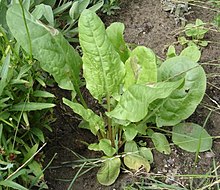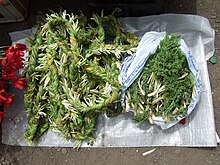Meadow Sorrel
| Meadow Sorrel | ||||||||||||
|---|---|---|---|---|---|---|---|---|---|---|---|---|

Common Sorrel ( Rumex acetosa ) |
||||||||||||
| Systematics | ||||||||||||
|
||||||||||||
| Scientific name | ||||||||||||
| Rumex acetosa | ||||||||||||
| L. |
The Common Sorrel ( Rumex acetosa ) and sorrel , Sauerlump (Saxony) or Suurampfere (Switzerland) called one's plants art that the family of Knotweed is one (Polygonaceae). It is used as a wild vegetable and medicinal plant.
description
The common sorrel grows as a perennial herbaceous plant and reaches heights of 30 to 100 centimeters. A fibrous rhizome with strong shoot roots serves as a perennial organ . The lower leaves are elongated and elliptically elongated in shape, while the leaves that arise further up the stem are arrow-shaped. Its bag-shaped leaf sheaths ( ochrea ) are the result of the growth of the stipules and serve as bud protection.
The flowering period extends from May to August. The meadow sorrel is dioecious ( diocesan ). On the leafless inflorescence shafts are the panicle, thyrsen-shaped total inflorescences , which consist of dichasial coiled partial inflorescences . The relatively small flowers are red. The inner three tepals have a red border and continue to grow (with the female flowers) after the anthesis and then envelop the small nut fruits as " valves " .
Occurrence
The original distribution area of sorrel includes Europe, Asia, North Africa and Australia. In North and South America it is a neophyte. It can be found from the valley to the lower alpine area and thrives best on moderately dry to moist soils. Further requirements for the soil are an acidic soil environment (pH value below 7), a moderate nutrient content and only little phosphorus available to plants. The soil quality is ideally a deep, loose loam, clay or peat soil. It is a character species of the class Molinio-Arrhenatheretea, but has its focus in societies of the order Arrhenatheretalia.
Ecology and problems in agriculture
Sorrel is a problem in intensive grassland management because its seeds not only survive in the soil for several years, but also remain viable in the liquid manure . This allows it to spread en masse in favorable locations and displace forage grasses . Combating it poses a major problem, as its storage roots, which are up to 1.5 m deep, remain capable of regeneration even in small parts and form new plants.
It is considered a pointer plant for grassland primarily fertilized by manure . Here it is undesirable because it is difficult to preserve in silage or hay and is avoided by cattle.
The common sorrel is a perennial, mostly evergreen semi-rosette plant. Vegetative reproduction takes place especially after damage by root shoots.
In terms of flower ecology, the meadow sorrel is wind-flowered and belongs to the "long-dust thread type". The number of chromosomes is 2n = 14 in females, 2n = 15 in males. Female plants have 2 X chromosomes, male 1 X and 2 Y chromosomes. There is a high pollen production ; 30,000 pollen grains are produced per stamen and 300 million per inflorescence.
Together with an air-containing callus and through wing formation, the valves serve as a spreading organ. Propagation occurs through the wind and as water-borne, in addition, coincidental propagation takes place through ungulates and swimming. Fruit ripening is from June to August. The long-lived seeds are light germs .
The Sorrel is a food plant for the caterpillars of the Adscita Statices , the Alpine Grünwidderchen Violet fire moth , the brown moth fire , the small fire moth and Dukaten moth .
The rust fungi Puccinia phragmitis var. Phragmitis , Uromyces acetosae , Puccinia acetosae and Uromyces rumicis occur on the leaves of the sorrel. The Peronospora rumicis fungus also parasitizes on it frequently.

Systematics
One can distinguish the following subspecies:
- Rumex acetosa subsp. acetosa : It occurs in Eurasia, Australia and Morocco.
- Rumex acetosa subsp. biformis (Long) Castrov. & Valdés Berm. : It occurs in Spain, France and Great Britain.
- Rumex acetosa subsp. hibernicus (Rech. f.) Akeroyd : It occurs in England, Scotland, Wales and Ireland.
ingredients
The sorrel contains a lot of vitamin C . It can be cooked as wild vegetables or eaten raw. However, due to the relatively high content of potassium hydrogen oxalate , especially in children, after copious consumption of leaves, pronounced oxalate poisoning can occur. Oxalic acid promotes the development of kidney and bladder stones . Poisoning with grazing cattle is also not uncommon. Sheep are particularly sensitive, while cattle are more resilient.
history
Even in ancient times , the Egyptians , Greeks and Romans used sorrel to compensate for excess fatty foods at their feasts. In the Middle Ages , the sorrel was widespread, especially in the British Isles. It was thought to have an antipyretic effect. In addition, sorrel was already known to seafarers in the Middle Ages as a remedy for scurvy .

use
When collecting sorrel, make sure that it does not come from over-fertilized meadows. Only specimens with flawless leaves should be selected. Older specimens with rust-brown holes in the leaf are particularly unsuitable in larger quantities.
You can prepare sorrel like spinach , or mix it with it to create a slightly spicier taste. It is also used as a salad or in creamy dock soup . The amperf soup is particularly well-known and popular in Belgium and France, but also in Eastern Europe, especially Poland and Lithuania. It tastes hot and also ice-cold. In Hungary , sorrel leaves ( sóska ) are strained, boiled, thickened with sour cream and flour and seasoned with sugar, similar to cream spinach . Jacket potatoes and fried eggs are also eaten. Passed sorrel is also available frozen in Hungary. Young sorrel leaves can be cut into salads or added to sauces and omelets . Sorrel is one of the seven herbs that are traditionally used in Frankfurt green sauce .
For digestive problems, sorrel can be taken as a remedy . Although sorrel contains a large amount of iron, consumption should be avoided if there is a lack of iron , as the oxalic acid contained in high concentrations inhibits iron absorption.
Cultivation
The sorrel is now occasionally grown in the garden. The sowing takes place in the spring (approx. Mid-March) on moist soil in rows, later the young plants are separated to 20 cm. The young, tender leaves are picked. Late sowing in August is also possible; the harvest of these plants begins the following year.
literature
- Avril Rodway: Herbs and Spices. The most useful plants in nature - culture and use . Tessloff Verlag, Hamburg 1980, ISBN 3-7886-9910-8 .
- Ruprecht Düll , Herfried Kutzelnigg : Pocket dictionary of plants in Germany and neighboring countries. The most common Central European species in portrait. 7th, corrected and enlarged edition. Quelle & Meyer, Wiebelsheim 2011, ISBN 978-3-494-01424-1 .
- Lutz Roth, Max Daunderer , Kurt Kormann: Poison Plants - Plant Poisons. Poisonous plants from AZ. Emergency assistance. Occurrence. Effect. Therapy. Allergic and phototoxic reactions. 4th edition. Nikol, Hamburg 2000, ISBN 3-933203-31-7 (reprint from 1994).
Web links
- Meadow Sorrel. In: FloraWeb.de.
- Distribution map for Germany. In: Floraweb .
- Rumex acetosa L. In: Info Flora , the national data and information center for Swiss flora . Retrieved October 5, 2015.
- Distribution in the northern hemisphere according to: Eric Hultén , Magnus Fries: Atlas of North European vascular plants 1986, ISBN 3-87429-263-0
- Thomas Meyer: Data sheet with identification key and photos at Flora-de: Flora von Deutschland (old name of the website: Flowers in Swabia )
- Kitchen lore: sorrel
- Cooking tips on biogemuese.de
Individual evidence
- ↑ a b c d e Rumex in the Germplasm Resources Information Network (GRIN), USDA , ARS , National Genetic Resources Program. National Germplasm Resources Laboratory, Beltsville, Maryland. Retrieved August 15, 2017.
- ↑ Agroscope shutdown of the institute's website or merging with the website of the Agroscope research institutes Changins-Wädenswil ACW and Liebefeld-Posieux ALP. Reckenholz-Tänikon ART [1]
- ↑ a b c Erich Oberdorfer : Plant-sociological excursion flora for Germany and neighboring areas . 8th edition. Verlag Eugen Ulmer, Stuttgart 2001, ISBN 3-8001-3131-5 . Page 331.
- ↑ Entomologenportal.net ; Retrieved June 10, 2012
- ↑ Peter Zwetko: The rust mushrooms Austria. Supplement and host-parasite directory to the 2nd edition of the Catalogus Florae Austriae, III. Part, Book 1, Uredinales. Austrian Academy of Sciences, Vienna, 2000. online
- ^ British Mycological Society, accessed January 25, 2014



